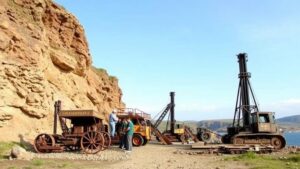Tracing Historical Charcoal Kiln Records for Early Manufacturing Tools
Tracing Historical Charcoal Kiln Records for Early Manufacturing Tools
The study of charcoal kilns serves as a gateway to understanding early manufacturing and the development of tools used in various industries. Charcoal production was integral to metallurgical processes, and its records offer valuable insights into early industrial practices. This article explores the historical significance of charcoal kilns, examines their architectural evolution, and delves into their role in the production of early manufacturing tools.
Historical Context of Charcoal Production
Charcoal has been used since ancient times as a fuel source for metallurgy and blacksmithing. earliest known references to charcoal production date back to approximately 4000 BC in ancient Egypt, where it was used in the smelting of copper. By the Middle Ages, the demand for charcoal increased due to the burgeoning iron industry in Europe.
- In Sweden, the 12th century saw extensive use of charcoal for iron smelting, with records indicating over 9,000 charcoal kilns were operational by the late 1500s.
- The charcoal kiln design evolved significantly, transitioning from simple pit kilns to more complex structures such as the beehive kiln, which improved efficiency and yield.
Architectural Evolution of Charcoal Kilns
The architecture of charcoal kilns reflects the technological advancements of the respective periods. Early kilns were typically earth pits, but as the need for higher production rates rose, brick and stone structures became commonplace.
- One example includes the traditional beehive kiln, which consisted of a dome-shaped structure that provided better thermal efficiency. e kilns averaged a height of 4 to 5 meters and could produce between 40 to 150 bushels of charcoal in one firing.
- In the 19th century, more sophisticated designs emerged, including the continuous kiln and the retort kiln, which further optimized the carbonization process and improved heat retention.
Impact on Early Manufacturing Tools
Charcoal production was intrinsically linked to early manufacturing tools, primarily in the iron and steel industries. Tools such as hammers, anvils, and later, cutting tools were made possible through the carbonizing process of charcoal.
- The steel produced using charcoal–a process known as charcoal iron–was pivotal from the 18th century onwards, as it allowed for the manufacturing of superior tools that were critical during the Industrial Revolution.
- Notably, the production of high-quality Scandinavian steel, such as Tama steel made using charcoal, was revered across Europe for its durability and strength.
Charcoal Kiln Records: A Methodological Approach
Historical records of charcoal kilns provide essential data for researchers studying early manufacturing practices. These records include maps, production logs, and archaeological findings that highlight kiln operations and their impact on local economies.
- For example, a study of the charcoal kilns in Pennsylvania during the 1800s revealed that up to 10,000 kilns existed in the region, producing charcoal for nearby ironworks.
- Similarly, archaeological excavations in the UK have uncovered kiln sites dating back to the Roman period, revealing insights into the organization of labor and resources in ancient manufacturing.
Conclusion and Future Research Directions
The tracing of historical charcoal kiln records is not merely an exploration of antiquated technology; it is a profound journey into understanding the foundations of early manufacturing practices that shaped modern industry. Further research can enhance our understanding of the socio-economic impacts of charcoal production and its lasting legacy in the development of manufacturing tools.
Future studies could involve:
- Advanced archaeological methods such as geophysical surveys to identify unexcavated kiln sites.
- Digital archiving of charcoal production records to create comprehensive databases accessible for academic and industrial use.
In summary, charcoal kilns are pivotal to the history of manufacturing tools, serving as both a practical application and a historical record of industrial evolution.


